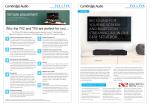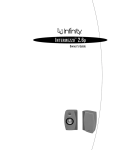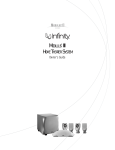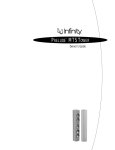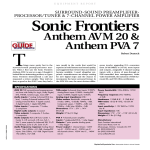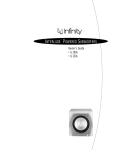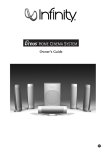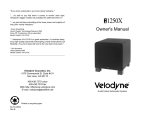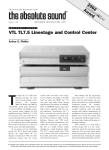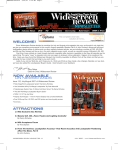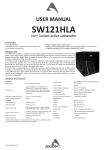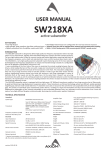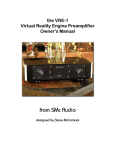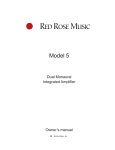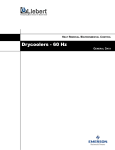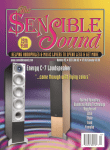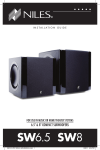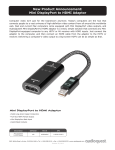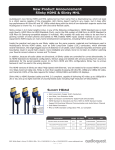Download 3D Connexion IL120s User's Manual
Transcript
108-0111-Infin-p074-76,78x 1/24/02 1:32 PM Page 74 EQUIPMENT REPORT SUBWOOFER Infinity Systems Interlude IL120s A s everyone—at least, everyone who reads this magazine—knows, the sound of a subwoofer in a room depends not only on the subwoofer itself, but also on the room and the placement of the subwoofer in the room. You can have a subwoofer that’s a sterling performer when measured anechoically, but that performance may not be realized in a given hometheater setting. While some of us are in the fortunate position of being able to build a dedicated home-theater room of ideal proportions, most of us are stuck with the rooms we’ve got, which leaves subwoofer position as a variable to be optimized. There are formulas and computer programs that will suggest subwoofer positioning, but, in my opinion, these are not as use- Robert Deutsch ful as they seem. The ones I’m familiar with all use a mathematical model that assumes a shoebox-shaped room with no openings in the walls, and walls of infinite rigidity. Real rooms may be L-shaped and have doors, archways, closets, skylights, and cathedral ceilings—variables that can’t be plugged into the formulas. Real walls typically have rigidity that is considerably less than infinite, which can affect the usefulness of the result in ways that are often unpredictable. One bit of advice that’s hard to argue with is that the subwoofer should be moved around until you find the position that produces the best bass—i.e., the greatest extension, the most output, the flattest frequency response, and the smoothest integration SPECIFICATIONS Interlude IL120s ported active subwoofer Driver: one 12" C.M.M.D. cone Frequency response: 28–150Hz, ±3dB Amplifier output: 500W (20–150Hz, <0.1% THD) Crossover frequencies: 50–150Hz, 24dB/octave, continuously variable Controls: subwoofer level, phase (0°/180°), crossover frequency, R.A.B.O.S. (see text) Finishes: cherry, natural maple, onyx-onigre Dimensions: 171⁄2" × 171⁄4" × 193⁄4" (H×W×D) 74 Stereophile Guide to Home Theater • November 2001 Weight: 45 lbs. Price: $899; Bass Optimization Test & Measurement Kit, $59.95 Manufacturer Infinity Systems 250 Crossways Park Drive Woodbury, NY 11797 tel. (800) 553-3332 fax (516) 682-3524 www.infinitysystems.com with the main speakers. Fair enough, but even if you ignore the possibility that you’ll have to make tradeoffs among the different criteria of subwoofer performance (for instance, the position that gives you the highest output might not produce the smoothest integration), this approach assumes that you have considerable flexibility in subwoofer positioning. Again, the reality may be quite different. The position that’s ideal for the subwoofer may be exactly where you have the equipment rack, with no other convenient place in the room to put the equipment. Or the subwoofer might sound best when placed in a position that will almost guarantee that people will trip over it or its cables. Equalization One approach to improving in-room subwoofer performance is equalization: attenuating the peaks and boosting the valleys, a process intended to produce an overall more linear frequency response. Unfortunately, there are several pitfalls to using conventional equalization in this fashion. First, boosting a frequency that corresponds to a dip in the frequency response is not advisable. A dip usually indicates acoustic cancellation, and boosting the level at this frequency is like feeding power into an acoustic black hole. You’ll end up pushing the subwoofer to high output levels, with little to show for it, except possibly driving the woofer into audible distortion. Attenuating a peak might be effective, 108-0111-Infin-p074-76,78x 1/24/02 1:32 PM Page 75 PHOTOS © 2001 CORDERO STUDIOS INFINITY SYSTEMS INTERLUDE IL120S but, as work by Floyd Toole and his associates at the National Research Council in Ottawa has shown, the bandwidth of the sort of peak you’re likely to encounter with subwoofers is often narrower than the traditional third-octave Real Time Analyzer (RTA) measurement can detect, and correcting it requires attenuation with a correspondingly narrow bandwidth. (I recently attended a talk given by Toole at a meeting of the Toronto chapter of the Audio Engineering Society, where he exhorted the assembled AES members—most of whom work in pro audio—to throw away their third-octave RTAs.) R.A.B.O.S. Floyd Toole—now vice president of engineering at Harman International Industries, Inc., of which Infinity Systems is a division— acknowledges that optimizing subwoofer performance starts with positioning the sub- woofer in the room, and that this typically involves some practical constraints. However, while rejecting the use of conventional RTA-based equalization, he suggests that a subwoofer’s performance can be improved considerably using what he and Allan Devantier, Harman’s director of engineering and another National Research Council alumnus, call R.A.B.O.S.: Room Adaptive Bass Optimization System. This is a dedicated low-frequency measurement and equalization system incorporated into Infinity’s current line of subwoofers and full-range speakers that include a subwoofer (including the Prelude MTS, reviewed by Joel Brinkley in the July/August 2000 issue of the Guide). R.A.B.O.S. is supplied as an optional Test & Measurement Kit that contains a specialized sound-level meter, test CD, measurement templates, bandwidth selector, and an adjustment “key.” (An adjustment key is included with the IL120S even if you don’t get the Test & Measurement Kit. In that case, you can try adjusting the controls by ear, listening to music of appropriate bass content.) The frequency bands on the test CD that form the basis of the measurement cover the bass range with much greater resolution than a third-octave RTA: there are 23 test frequencies from 20Hz to 100Hz . R.A.B.O.S. employs a type of parametric equalizer, and differs in several important respects from conventional RTA-based approaches. The parameters that can be adjusted are level, bandwidth, and frequency. The controls for level (attenuation only, from 0dB to –14dB) and bandwidth (from 5% to 50% of an octave) each have 21 steps. The frequency control has 19 steps from 20Hz to 80Hz, each corresponding to frequencies on the test CD. The setup procedure requires that you first plot the subwoofer’s response using the test frequencies and the sound-level meter, Stereophile Guide to Home Theater • November 2001 75 108-0111-Infin-p074-76,78x 1/24/02 1:32 PM Page 76 INFINITY SYSTEMS INTERLUDE IL120S phase-reversal switch and a continuously variable lowpass filter that can be turned off if the subwoofer is used with a Dolby Digital/DTS surround processor-receiver. The IL120S’s sculpted front panel and grille are attractive, and the review sample was finished in “onyx-anigre,” which I take to be a term for a better class of fake wood. which determines the frequency of the dominant subwoofer/room peak as well as the shape of that peak. You then set the bandwidth control to match the shape of the peak, and attenuate level at the appropriate frequency by an amount that will produce a flat frequency response. After the equalization process is completed, you can check the results by repeating the test tones and plotting the frequency response again. R.A.B.O.S. can correct for only a single dominant peak, but this is said to be the most common subwoofer/room interaction. In situations where there are two significant peaks, the R.A.B.O.S. manual suggests correcting the one at the higher frequency, which is likely to be more audible and objectionable. If there are adjacent narrow peaks and dips, the manual says to leave them alone—they’re the result of interference patterns that are specific to a certain spot in the room, and in any case can’t be corrected by this type of equalization. 76 Stereophile Guide to Home Theater • November 2001 Oh yes, the subwoofer . . . Aside from the R.A.B.O.S. function, the IL120S looks like a fairly conventional powered subwoofer with a rear-facing port that’s flared to reduce turbulence. The IL120S is not one of those newfangled ultra-compact subs, and does not have servo control. However, it does have one high-tech feature: the driver is a special 12-inch unit with a proprietary Ceramic Metal Matrix Diaphragm (C.M.M.D.) and a 60-oz magnet structure. According to research reported in a white paper on www.infinitysystems.com, loudspeaker cones made of C.M.M.D. have fewer inherent resonances and are capable of more linear pistonic movement than any other comparable material. The effect is said to be the elimination of colorations due to cone modes, which should result in dramatically reduced distortion. Amplification is provided by a 500W class-AB amplifier with a cool-running switching power supply. In addition to the R.A.B.O.S. controls, the IL120S includes a Listening Before trying to fine-tune the IL120S with R.A.B.O.S., I wanted to check out its raw performance with the R.A.B.O.S. controls turned off completely. I set up the IL120S as per my usual practice: sub placed at front left, just a bit out from the corner, the main speaker/subwoofer balance adjusted using the built-in calibration tones of the Rotel RSP-976 surround preamplifier-processor—or, when using the Thule PR 250B processor (which lacks a subwoofer calibration tone), the test tones on Stereophile’s Test CD 3. To ensure comparability with my previous subwoofer reviews, I used a RadioShack sound-level meter. Over a period of several weeks, watching familiar DVDs as well as new releases (I rent many more than I buy), the impression that I formed of the IL120S was that, for $899, it’s a competent but unexceptional performer. Extension was good, and there was lots of volume available, but the bass was a bit boomy, lacking some tightness. I played REVIEW SYSTEM Sources Rotel RDV-1080 DVD player JVC HR-4700U VCR Surround Preamp-Processors Rotel RSP-976 Thule PR 250B Power Amp Bryston 9B-ST Speakers Dunlavy SC-I (5) Cables Digital: TARA Labs Decade Interconnect: assorted AudioQuest Speaker: AudioQuest Type 6+ Misc. Chang Lightspeed CLS HT1000 power-line conditioner AudioPrism QuietLine LF-1 Mk.II parallel power-line filters 108-0111-Infin-p074-76,78x 1/24/02 1:32 PM Page 78 INFINITY SYSTEMS INTERLUDE IL120S around with the surround preamp-processor’s subwoofer-level control but couldn’t get rid of the boomy quality without making the subwoofer sound too weak. For the price, the performance was still good enough to earn a recommendation, but nothing to get too excited about. Once I felt I had a good handle on the IL120S’s basic sound, it was time to try R.A.B.O.S. I set up the sound-level meter on a short tripod placed at the central listening seat and began adjusting first system volume, then subwoofer volume, as instructed by the R.A.B.O.S. manual. That is, I tried to—before I was able to finish making these adjustments (which are preliminary to the fine-grained measurement/equalization process), the sound-level meter’s Low Battery warning light came on. The meter had been on perhaps 15 minutes. Could the meter’s 9V alkaline battery have been on the low side to begin with? Perhaps. I replaced it with a new battery. Another 15 minutes or so of testing, and the Low Battery light came on again. Suffice it to say that I exhausted four batteries during the R.A.B.O.S. measurement process, and would have needed even more had I not started turning the meter off at 78 Stereophile Guide to Home Theater • November 2001 every opportunity. I talked to Allan Devantier at Infinity about the meter’s batteryeating habits, and he admitted that the meter draws considerable current, but said that this was a byproduct of making it behave linearly at the low frequencies required for accurate R.A.B.O.S. measurements. I think the Infinity people were gotten to by the Energizer bunny. Apart from having to watch for that pesky Low Battery warning, the process of taking the R.A.B.O.S. measurements, plotting the results, and making the adjustments turned out to be easier than I had anticipated. The plot of the frequency response based on the R.A.B.O.S. measurements showed that there was just a single 6dB peak centered at 40Hz, and the bandwidth selector (a neat, curve-fitting device) indicated that the correction should have a 30% bandwidth. Then it was a simple matter of looking up in the R.A.B.O.S. manual the control settings corresponding to these parameters (e.g., 40Hz is Position 11 of the Frequency control), and, with the aid of the adjustment key (a kind of small screwdriver), turning the equalizer controls to the appropriate settings. I then repeated the measurements to check the effect of the R.A.B.O.S. adjustments. The plot of the retest showed that the peak centered at 40Hz was essentially eliminated, with no change elsewhere in the frequency response. (Actually, there was still a 1dB blip at 40Hz, but I decided to leave it alone.) The last stage was setting the final system balance, using another pair of test signals on the R.A.B.O.S. test CD. Comparing the sound of the system with R.A.B.O.S. engaged vs. bypassed (the subwoofer has a switch that allows you to do this), using R.A.B.O.S. resulted in the IL120S sounding much more subtle and natural, more of-a-piece with the rest of the range. The bass drum in Jumanji—the scene where the children run upstairs to look for whatever is making that ominous throbbing sound—became tighter, not as boomy, with less of a sense of prolonged resonance. The bass also seemed to go deeper. I initially found the increase in apparent bass extension puzzling, in that the before/after frequency-response plot showed no changes in the region of 30Hz and below. However, the impression of greater bass extension does make sense when you consider the fact that R.A.B.O.S. lowered the 40Hz peak while leaving frequencies below 30Hz unaffected. This would have the effect of the lower frequencies being given more nearly equal prominence with the higher ones—which means, effectively, greater bass extension. The IL120S’s rated low-end limit is 28Hz, –3dB, and that’s pretty much how it sounded with the R.A.B.O.S. adjustments. More upmarket subwoofers—like the Bag End Infrasub-18 and the big Velodynes—go lower and with more authority, but within its range the IL120S actually had them beat in linearity of in-room frequency response. I just wish the powered subs of my Avantgarde Unos in my 2-channel listening system were equipped with R.A.B.O.S. controls. The improvements brought about by R.A.B.O.S. were especially welcome with music. There’s a tendency for the bass in subwoofer-equipped systems to sound disconnected from the rest of the range, which is more bothersome with music than with movie sound effects. With R.A.B.O.S., there was better integration of the sound of the IL120S with the main speakers, for a more musically appropriate effect. The bass was also more “tuneful”—it was easier to follow string bass and bass guitar lines in the mix. Conclusion Considered without the R.A.B.O.S. parametric equalizer function, the IL 120s impressed me as a good subwoofer for the price, but not one that stands out in any major way from the competition. But the R.A.B.O.S. adjustments produced significant improvements in measured and subjective performance, the frequency response becoming much more linear, with audible improvements in bass evenness, tightness, and apparent extension. As far as I’m concerned, the IL120s, with R.A.B.O.S. optimized, is now the subwoofer to beat in the under-$1000 category.




